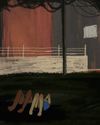Zine
Computer Arts - UK
|Spring 2019
Emily Gosling investigates how today’s designers are tapping into the deliberately chaotic, cut ’n’ paste approach that zines from the 70s and 90s made their own
-

Subversion and the idea of both fucking with and forging a DIY path around the ‘system’ has always been at the very heart of zine culture. The zine aesthetic – both visually and conceptually – is the ultimate manifestation of ripping it up and starting again, the idea that formed the core of punk culture, post-punk culture (we have Scottish post-punk purveyors Orange Juice to thank for the popularisation of the phrase), and youth culture more generally.
The word zine is simply a shortened version of magazine, or more usually, fanzine, but in its snappier, four-letter form it has far more significant connotations. ‘Zine’ – at least, in its origins – speaks of bedroom activism, of punk, of the dissemination of ideas that otherwise may not be circulated: those around queer sexualities perhaps, or underground music scenes, or simply fandoms so niche there isn’t a hope in hell of seeing them in print-titles-proper.

The aesthetic most of us associate with zines today – a visual chaos of cut-and-paste imagery, deliberately scrappy approaches to layout, maelstroms of numerous different typefaces, strange photographic crops, hand-scrawled notations – exploded in the 1970s with the birth of punk. Vitriol and ebullience alike were expressed in print as hastily put-together pages that indulge in their underground, countercultural status; the most famous of which are Sniffin’ Glue, Mark Perry’s zine from 1976 to 1977, and its US peer Search and Destroy, published by V Vale between 1977 and 1979.
Esta historia es de la edición Spring 2019 de Computer Arts - UK.
Suscríbete a Magzter GOLD para acceder a miles de historias premium seleccionadas y a más de 9000 revistas y periódicos.
¿Ya eres suscriptor? Iniciar sesión
MÁS HISTORIAS DE Computer Arts - UK
Computer Arts - UK
Creative Space
Without’s creative director roly grant on the studio’s hand-crafted ethos
2 mins
June 2020
Computer Arts - UK
studio profile
A leading light in the branding industry, Wolff Olins wants to harness its scale to help change the world
8 mins
June 2020

Computer Arts - UK
network
THE CREATIVE COMMUNITY HAS COME TOGETHER LIKE NEVER BEFORE, TO HELP EACH OTHER GET THROUGH THE CORONAVIRUS PANDEMIC
2 mins
June 2020

Computer Arts - UK
project
ethos for 305 Fitness - Learn how the Montreal identity design studio rebranded one of America’s hottest fitness clubs
5 mins
June 2020

Computer Arts - UK
rebrand
WHAT’S THE EXPERT OPINION ON PENTAGRAM’S BRAND IDENTITY REFRESH OF THE GLOBAL TOY COMPANY FISHER-PRICE?
3 mins
June 2020
Computer Arts - UK
opinion
CRAIG BLACK HAS SOME ADVICE FOR SURVIVING THE CORONAVIRUS CRISIS AS AN INDEPENDENT CREATIVE
5 mins
June 2020

Computer Arts - UK
fresh eyes
DUNCAN BRAZZIL ON HOW THE UK INSPIRED HIS CAREER
1 min
June 2020

Computer Arts - UK
artist insight
Cindy Kang on how photography informs her illustration work
5 mins
June 2020
Computer Arts - UK
ANIMATION NOW
LEADING PRODUCERS AND FILMMAKERS REFLECT ON EMERGING TRENDS AND SHARE THEIR PREDICTIONS FOR THE YEAR AHEAD
17 mins
June 2020
Computer Arts - UK
Project: Atoll by Studio Myerscough
Morag Myerscough reveals how she and Luke Morgan designed a vibrant biophilic installation in a central London office tower studiomyerscough.com
4 mins
May 2020
Translate
Change font size

